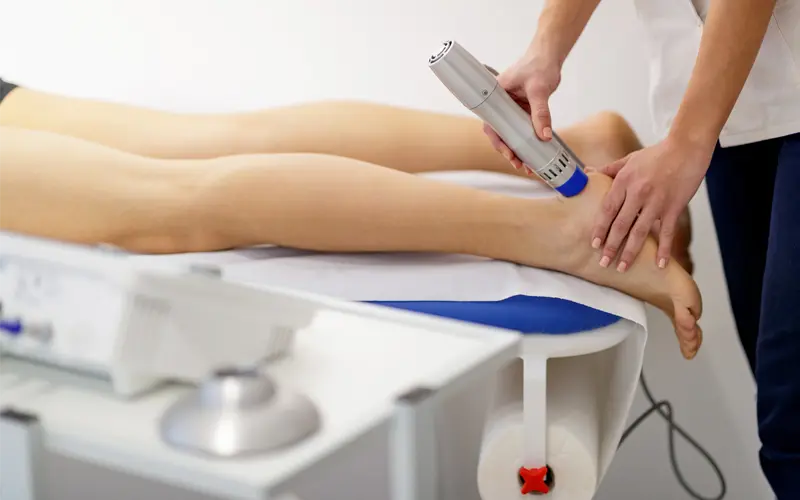Extracorporeal Shock Wave Therapy

What is extracorporeal shockwave therapy (ESWT) and how does it work?
Extracorporeal shock wave therapy utilizes ultrasound and sound waves, similar to the procedure of breaking down kidney stones. Extracorporeal shock wave therapy is not a new treatment but has been used across Canada and Europe for over a decade. At Cambridge Foot and Ankle, we utilize ESWT to treat recalcitrant cases of tendonitis and inflamed ligaments, specifically Achilles tendinitis and plantar fasciitis.
ESWT is completely noninvasive, and there is no need for general anesthesia. The procedure can be completed in the doctor’s office, so you won’t have to go to the hospital or surgery center for the procedure. You will be given a local anesthetic to stop any pain or discomfort during the procedure. Patients are able to walk after the surgery, and depending on your work situation, you should be able to return to work immediately. If you have an active job, you should take at least 3 to 5 days to stay off your feet to allow the treatment to be as effective as possible.
What are the primary benefits of extracorporeal shock wave therapy?
Extracorporeal shock wave therapy is a non-invasive procedure and does not require surgery.
- There is no skin incision required.
- There is no anesthesia involved.
- There is a 0% change of post-operative complications.
What are treatment options leading up to extracorporeal shock wave therapy?
Providing conservative care is step one in treating tendonitis and fasciitis injuries. These include things like orthotics, physical therapy, home stretching, injections, etc.
Who are the best candidates for extracorporeal shock wave therapy, and who would not be recommended for this treatment?
The best candidates for ESWT are people with an issue such as Achilles tendinitis or plantar fasciitis and those who have failed at other forms of conservative care. In the case of Achilles tendinitis, the patient would have tried home stretching, orthotics, night splints, topicals, anti-inflammatory medications and physical therapy with no relief. With a choice of surgery or ESWT, extracorporeal shock wave therapy is a no brainer since there are little to no contraindications with ESWT. There are few people who would not qualify for this treatment option.
What does the extracorporeal shock wave therapy procedure entail? (i.e. How many visits does it require, are there any side effect, what is the recovery time, etc.)
Extracorporeal shock wave therapy is primarily used to treat Achilles tendinitis and plantar fasciitis. Depending on the area being treated, the patient is seen in the office and is given a local anesthetic to numb the area. Most patients require only 1 visit and 1 treatment, making this an extremely cost-effective procedure. The treatment takes anywhere from 15 to 22 minutes depending on the area. Regarding potential issues, there is a low risk of side effects due to the non-invasive approach. Recovery often entails wearing a walking boot for up to 2 weeks. We encourage patients not to take anti-inflammatory medication, as this could hinder the effectiveness of the treatment since the goal is to create inflammation. We also discourage icing, stretching and physical therapy since we want the body to use its natural mechanisms to try and heal the affected area.
How does the equipment work, and does ESWT cause any external trauma, such as bruising?
You shouldn’t see bruising after the procedure, though ESWT causes a “bruising” or trauma to the tissue at the cellular level. The goal is to cause a new inflammatory response to begin the healing process.
Will I experience any pain or discomfort during the ESWT procedure?
Due to the local anesthetic, you should not feel any pain or discomfort during the extracorporeal shock wave therapy procedure.
What is the average recovery time for patients after undergoing extracorporeal shock wave therapy?
Recovery time will depend on the patient’s normal daily activities. Normal daily activity for one person could be a sedentary computer job whereas another person could be a competitive triathlete running 60+ miles a week. But for the average person, we usually advise two weeks in a boot to allow the foot to heal naturally, then they can go back to your normal daily activities.
Does ESWT require any co-treatment?
No, it is a standalone treatment. We encourage patients not to do home therapy or stretching for the first couple of weeks after the treatment. We also discourage the use of anti-inflammatory medications.
How effective is extracorporeal shock wave therapy?
ESWT has shown to be effective for 90%+ of patients who undergo the treatment.
Where does extracorporeal shock wave therapy come in the progression of treatment?
Extracorporeal shock wave therapy is often used when all other forms of non-conservative treatment have failed. ESWT is not a first-step treatment or a final treatment option but would be utilized when treatments like stretching, orthotics, professional physical therapy, night splints and other similar treatments have been ineffective.

Contact one of our Upperline Health clinics to get your Extracorporeal Shock Wave Therapy treatment started.
Treatments offered may vary by clinic.
